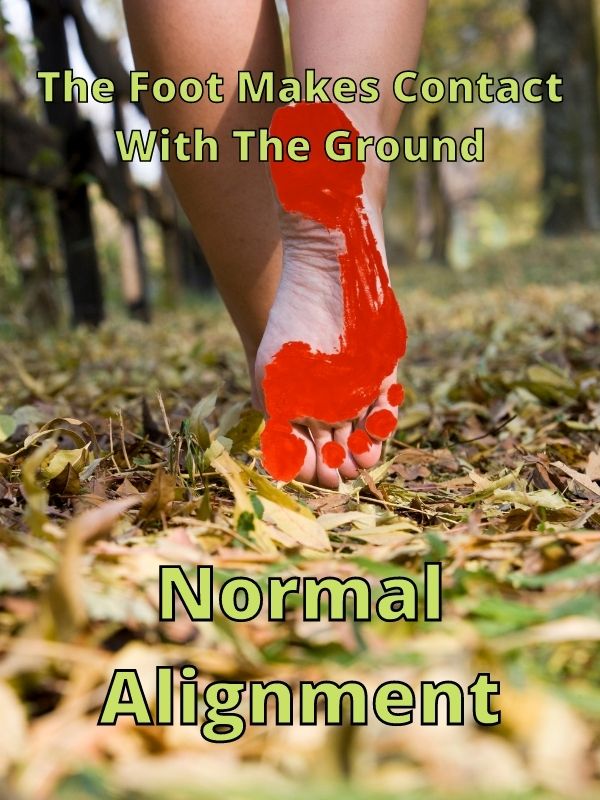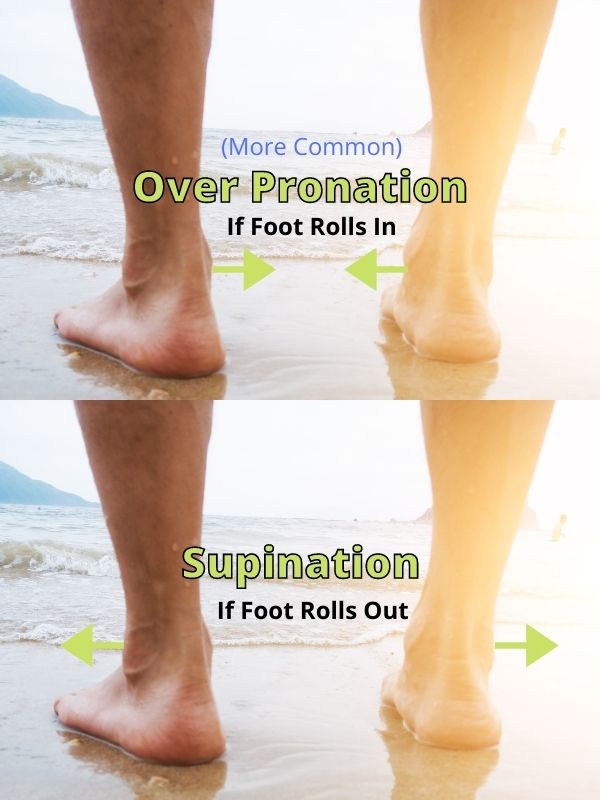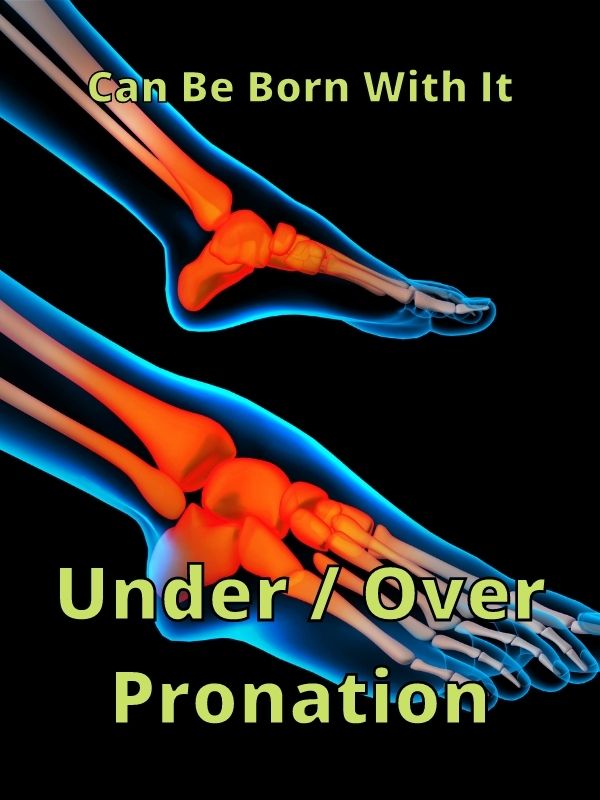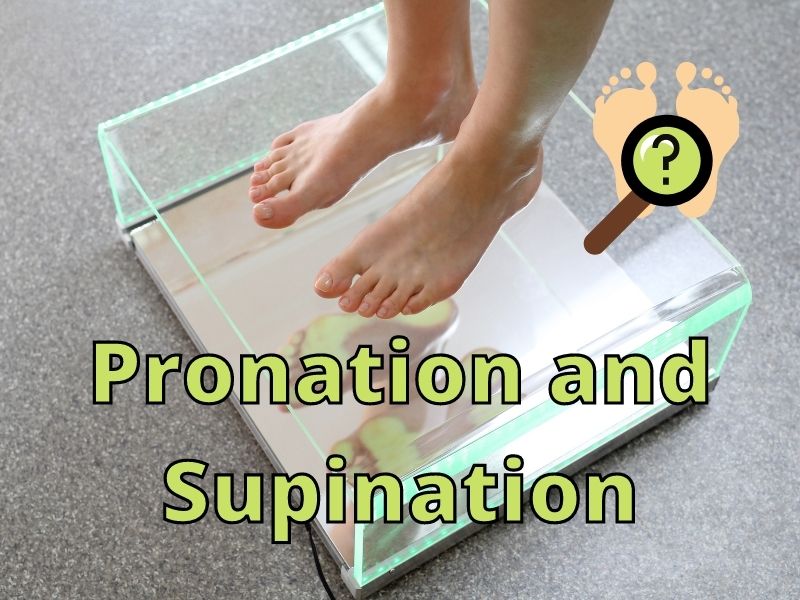Each of us may have a slight inward or outward tilt of our ankles when we walk. If you’ve been wearing shoes all your life, it’s almost impossible to have a perfectly aligned foot because shoes help shape how our feet work.
If someone’s ankles roll inward while standing still, this is called pronation. If the ankles roll away from the body, this is called supination. Some people use shoes to help with foot alignment. Others do exercises and/or visit a physical therapist to help with their muscles and foot alignment.
When I walk, I tend to supinate my feet a bit. My arches are about average, but others with flat feet mean their ankles roll in. My feet have changed over time as I’ve worn different shoes and done different types of exercises.
I started to see a bigger difference in muscle development when I started hiking more and using zero-drop shoes. What should you do if your foot rolls in or out? Below are ideas to help with developing healthy feet and choosing shoes best for your feet.
Have you ever thought about the importance of foot health when it comes to daily life? Did you know too little or too much foot rotation at the ankle may increase your risk for injury?
Many people may be unaware of what their natural walking looks like until they see it in a video. People can have neutral pronation, overpronation, or supination (also called underpronation).
It’s actually very rare that someone’s feet and the way they walk (their gait) are always balanced perfectly. So, regardless of your gait, there are ways to accommodate and help the foot move in a more neutral/normal way.
What is “Normal Foot Alignment”?

During normal alignment, you walk and run in a natural biomechanical manner. Although the foot rolls in a bit with each step taken, the alignment of the bones is normal. A normal walking stride results in our body shifting weight, so it puts pressure on most of the foot bottom from the heel to the big toe.
However, sometimes the ankle rolls too far outward or inward with each step and you can’t roll off of your toes naturally. The foot is supported on the outer or inner edge of the foot. This is where we see either overpronation or supination.
The goal when walking naturally is to roll from the heel, through the arch, and to the toes as you push off. Natural walking should be low impact and feel natural. The pressure on your sole should be distributed equally on the bottom of your foot and not on the inner or outer edge.
Sometimes, you can tell if your walking is natural until you take off your shoes and walk on a flat surface. Then, you can identify better if pressure is being placed on the inner or outer edge of your foot.
One way that may help you identify an inward or outward foot tilt is your arch. If your arch is collapsed, such as with flat foot individuals, then you likely have pronated feet. If you have a high arch, then you may have supinated feet.
If you want to check your arch type, you can take a photo of your arch as you stand normally, with your leg under your hips and your feet facing a natural forward position. A medium arch is what most often results in normal foot alignment.
Another approach to see if your arch is low or high is to ask someone to help outline your feet with a pencil as you stand on a piece of paper. Also, you can apply water to the bottom of your foot and stand on paper to see the outline of the bottom of your feet.
“Low arches will show most of your footprint, medium arches will show your footprint without inner arch area, and high arches will show mostly heel and ball areas of the foot.”(Link)
What Exactly are Overpronation and Supination?

Overpronation is essentially having a flat foot or lack of a normal arch. The foot (entire sole) touches the ground when one steps. This is more common than one may think, affecting 20-30% of the population. It’s actually more common than supination.
When our walking gait causes the foot to roll inward more than normal, overpronation occurs, which is problematic over time. One way to tell this of a person is to see where their shoes show signs of wear. It’s more worn on the inside of the shoe’s sole, then they have flat feet.
It’s not unusual that these individuals will experience hip, knee, and back pain or possibly plantar fasciitis. For overpronation, arch supports/orthotics and motion-control shoes are a must!
Supination or an “over” arch is when the body weight is placed on the outside of the foot when in stride, either walking or running. To notice this, you can see that a person will have uneven wear on the outside part of their shoe.
This kind of arch causes individuals to have ankle soreness, shin splints, and discomfort in the heels or sometimes the balls of the feet. Most injuries result in ankle twists since they are more prone to outward rolls of the ankle.
This can be common for runners and most athletes. Individuals with supination will need well-cushioned, flexible shoes.
How Does One’s Arch Become Over or Under-Pronated?

For many, they are born with the type of arch they have. However, injuries can also cause pronation or supination issues. Oftentimes, when it’s due to injury, it usually happens indirectly.
What do I mean by this? Well, if you injure your knee and cannot walk normally, you may use the other leg to compensate for the lack of normalcy in the injured leg. This causes more pressure to be on the other leg.
Over time, if left untreated, the arches will be affected. If one is not born with supination or pronation, nor has it been caused by injury, sometimes we can see this happen from those who are on their feet for increased and excessive amounts of time.
Weight can also play a factor and result in the loss of arch and cause flat feet. On the other hand, those who overwork their feet may have tight muscles that result in a high arch over time. They may need help to stretch and realign bones.
What To Do If One’s Foot is Over or Under-Pronated

There are many reasons for having an inward or outward tilt in your ankle. If you can’t seem to understand why your feet are over or under pronated, then the first step is to identify the problem.
Let a Doctor Check Your Feet
I always like to see a doctor if I have a problem where I’m not completely sure. To make sure you get a proper diagnosis of your feet, see a doctor. They can refer you to a specialist or a physical therapist who can help identify and correct problems with your arch and injuries.
Let Your Feet Heal
If you have an injury that hasn’t fully healed, it is important to give your foot the time to heal properly and get the strength back in your foot and ankle. Then, you can take it slow until you’re ready to apply full pressure to your foot.
Old injuries may have caused scar tissue that doesn’t stretch as well as your regular muscles. A doctor or physical therapist can help you choose the right therapy and shoes that you may need to correct any pronation.
Do Foot Exercises
If your feet haven’t had exercise in a while. it’s a good idea to exercise them. There are lots of exercises that can strengthen your feet and help them get stronger. Check this article for ideas. (See Article Here)
Regular walking can also be very beneficial in aiding the strengthening of your foot. If you have misaligned ankle bones, see a doctor first would be best. They can advise a good exercise program for your feet.
Make sure to have correctly supported feet. Your shoes should be specifically made for pronation or supination if you know your foot is over or under-pronated.
If you just have weak feet or were born with a low arch, zero-drop shoes may be one way to help activate more muscles in your feet. A shoe with a wide toe box can activate the toes and help strengthen muscles while you walk.
This can allow your feet to get stronger and gain muscle support over time. If your bones naturally don’t create an arch, then having strong muscles in your feet can help create some support.
Stretch Your Feet
Sometimes, the muscles in our feet can get tight over time. This can shorten the normal length of the muscle and start to pull the bones out of alignment.
You may need to stretch your feet regularly depending on the type of exercise you do regularly and the type of consistent strain you put your feet under.
Sometimes, you’ll need to learn proper techniques to stretch your foot the correct way for the pronation problem you have. A physical therapist should be able to help with the stretching and give you exercises and stretching techniques to use for your situation.
Make sure you find out how to stretch because stretching the wrong way can cause more problems.
Get The Right Shoes
You can get shoes that can help with supination and pronation. They are called by different names, but if you show up to a store and tell them about your foot, they should be able to get you shoes designed to address your foot type.
- Overpronation – When you overpronate, your arch may not be able to support your foot to help absorb the impact of walking and running. Getting shoes with good arch support can relieve some issues with pain, bone alignment, and comfort.
- Online or at the store, you’ll likely find shoes that have extra arch support for those whose ankle tilts inward. These shoes are often termed “flat feet shoes,” “overpronation shoes,” or “motion control shoes.”
- Supination – If you have high arches you might have ankle pain or may be more likely to have an injury when exercising or doing sports. A cushioned shoe can help reduce the shock to your feet.
- At the store, you can find shoes that help if your ankles tilt outward or you have high arches. These shoes are often termed “supination shoes,” “cushion shoes,” “neutral shoes,” or “high arch shoes.” These shoes usually have extra cushioning to help address the need for impact protection.
- Much of the time, supination shoes are made for runners, but you can also find shoes for walking or other activities if you look around.
The following shoes are made for running but you can use them for walking, for fashion, and for going out to run errands as well. There are plenty of walking shoes as well that are also designed for overpronation and supination.
My Picks For Pronation Shoes (Flat Feet)
1. Hoka One Gaviota 2
Pronators need motion control and these shoes definitely live up to that! This model is best as a road shoe, great for running or walking.
Based on research and reviews, one runner, who usually experiences pain, said they were able to run without experiencing any pain.
The sneakers aided in his recovery time as they have great stability features and cushioning. Other runners said it did not aggravate their knee and foot issues and provided stability during usage.
Further, if one has a wide foot, they come in wide sizes and many have been pleasantly surprised with the fit. As a bonus, they come in a multitude of colors to fit your preference!
2. Brooks Ariel 20
The most common words to describe these shoes, based on reviewers, have been ‘efficient’ and ‘reliable’. If you are looking to do more walking than running, these may be just the shoe for you!
The underfoot platform of the Brooks Ariel 20 is designed to protect from injury, providing lots of surface control. This sneaker is sure to provide quality performance through its utilization of modern technologies.
3. New Balance Rubix
If you are going for an aesthetically pleasing shoe, the New Balance Rubix will satisfy you above and beyond. Not only does this shoe consist of a pleasing design, but it also offers great flexibility when running.
To note, users said it fits true to size and is very durable on the roads. If you have a wide foot, keep in mind this shoe tends to fit on the narrower side.
My Picks For Supination Shoes (High Arches)
1. Adidas Solar Glide 3
AD
The cushion in this shoe is superb, with the famous Boost foam extending all the way up to the toe area.
There is a decent amount of mid-section support, which is crucial for underpronation as these individuals need soft, neutral shoes.
2. Asics Gel- Cumulus 22
If you have previously owned a pair of these in the past, let go of your past thoughts. They have been changed for the better this year! The ride is soft and comfortable.
It allows the foot to walk through the natural gait in comfort. Many users say this sneaker fits true to size and is available in wide, regular, or narrow fits. I encourage you to give this one a try!
3. Saucony Triumph 18
Saucony has widened the midsole to provide more volume and stability for the foot. They changed this model from the last to be less constricting and provide a more comfortable, cushy experience.
These are a brand with a good track record. If you need something that has cushion and looks fashionable, these might be the shoes you’re looking for.
Final Thoughts
So in thinking about foot health, it’s essential to understand your arch and how you can be adequately caring for your feet, providing the most support and right shoes specific to you.
I encourage you to learn your arch type and seek out the best shoes and activities that will help you if your feet roll in or out. The sooner we work on our foot health, the sooner we can make larger, more helpful changes in the long run that can affect our overall joint health.
Thanks for visiting Helpshoe.com
References
https://www.healthline.com/health/bone-health/whats-the-difference-between-supination-and-pronation







